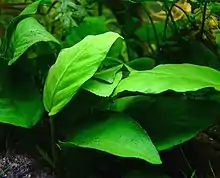| Anubias barteri | |
|---|---|
 | |
| Anubias barteri var. glabra | |
| Scientific classification | |
| Kingdom: | Plantae |
| Clade: | Tracheophytes |
| Clade: | Angiosperms |
| Clade: | Monocots |
| Order: | Alismatales |
| Family: | Araceae |
| Genus: | Anubias |
| Species: | A. barteri |
| Binomial name | |
| Anubias barteri | |
Anubias barteri is a West African species of Anubias, first described in 1860 by Heinrich Wilhelm Schott.[1] It occurs in south-eastern Nigeria, Cameroon and on Bioko.
Description
The form of the leaf varies widely between varieties; in A. barteri var. barteri (known as the "broadleaf Anubias"), the leaves are leathery, and may grow to 12 inches (300 mm). The rhizome remains above the substrate, tethered to litter like rocks and wood.
Cultivation
This plant grows well partially and fully submersed. In strong light, the leaves grow more quickly and remain more compact, but it tolerates a range of lighting. It prefers a temperature range of 72–82 °F (22–28 °C). It can be propagated by dividing the rhizome or by separating side shoots. If buried beneath a substrate, the rhizome may rot.[2]
Varieties
References
- 1 2 Crusio, W. (1979). "A revision of Anubias Schott (Araceae)". Mededelingen Landbouwhogeschool Wageningen. Primitiae Africanae XII. 79 (14): 1–48.
- ↑ "Anubias Barteri: Plant Types, Care, Propagation & Algae". Aquarium Care Basics. Retrieved 2022-02-19.